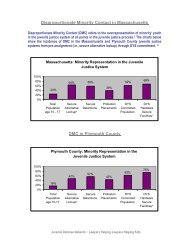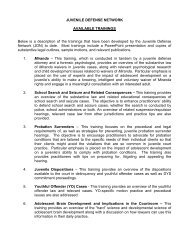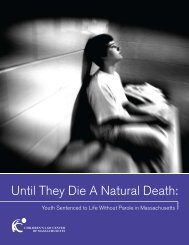States rethink 'adult time for adult crime' - the Youth Advocacy Division
States rethink 'adult time for adult crime' - the Youth Advocacy Division
States rethink 'adult time for adult crime' - the Youth Advocacy Division
Create successful ePaper yourself
Turn your PDF publications into a flip-book with our unique Google optimized e-Paper software.
Marois explained that he and Jones wanted to study <strong>the</strong> interactions among <strong>the</strong><br />
emotion-generating regions of <strong>the</strong> brain, like <strong>the</strong> amygdala, and <strong>the</strong> prefrontal<br />
regions responsible <strong>for</strong> reason. “It is also possible that <strong>the</strong> prefrontal cortex is<br />
critical <strong>for</strong> attributing punishment, making <strong>the</strong> essential decision about what<br />
kind of punishment to assign,” he suggested. Marois stressed that in order to<br />
study that possibility, more subjects would have to be put into <strong>the</strong> magnet. But if<br />
<strong>the</strong> prefrontal cortex does turn out to be critical <strong>for</strong> selecting among<br />
punishments, Jones added, it could be highly relevant <strong>for</strong> lawyers selecting a jury.<br />
For example, he suggested, lawyers might even select jurors <strong>for</strong> different cases<br />
based on <strong>the</strong>ir different brain-activity patterns. In a complex insider-trading case,<br />
<strong>for</strong> example, perhaps <strong>the</strong> defense would “like to have a juror making decisions on<br />
maximum deliberation and minimum emotion”; in a government entrapment<br />
case, emotional reactions might be more appropriate.<br />
We <strong>the</strong>n turned to <strong>the</strong> results of <strong>the</strong> second experiment, in which I had been<br />
asked to alternate between thinking of faces and places without disclosing <strong>the</strong><br />
order. “We think we can guess what you were thinking about, even though you<br />
didn’t tell us <strong>the</strong> order you started with,” Marois said proudly. “We think you<br />
started with places and we will prove to you that it wasn’t just luck.” Marois<br />
showed me a picture of my parahippocampus, <strong>the</strong> area of <strong>the</strong> brain that responds<br />
strongly to places and <strong>the</strong> recognition of scenes. “It’s lighting up like Christmas<br />
on all cylinders,” Marois said. “It worked beautifully, even though we haven’t<br />
tried this be<strong>for</strong>e here.”<br />
He <strong>the</strong>n showed a picture of <strong>the</strong> fusi<strong>for</strong>m area, which is responsible <strong>for</strong> facial<br />
recognition. It, too, lighted up every <strong>time</strong> I thought of a face. “This is a potentially<br />
very serious legal implication,” Jones broke in, since <strong>the</strong> technology allows us to<br />
tell what people are thinking about even if <strong>the</strong>y deny it. He pointed to a series of<br />
practical applications. Because subconscious memories of faces and places may<br />
be more reliable than conscious memories, witness lineups could be trans<strong>for</strong>med.<br />
A child who claimed to have been victimized by a stranger, moreover, could be<br />
shown pictures of <strong>the</strong> faces of suspects to see which one lighted up <strong>the</strong> facerecognition<br />
area in ways suggesting familiarity.<br />
Jones and Marois talked excitedly about <strong>the</strong> implications of <strong>the</strong>ir experiments <strong>for</strong><br />
<strong>the</strong> legal system. If <strong>the</strong>y discovered a significant gap between people’s hard-wired
















